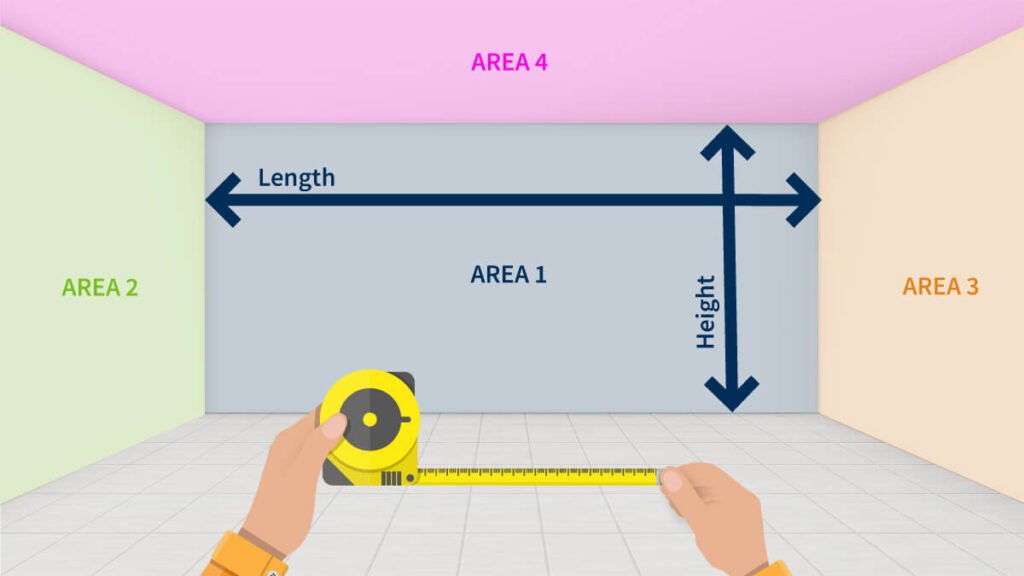Painting walls is a common and important task in home decoration or renovation. Whether it is to create a warm bedroom atmosphere or add a modern touch to the living room, the choice and amount of paint directly affect the decoration effect and budget. Accurately estimating the amount of paint needed can not only help you save costs but also reduce waste and avoid the trouble of construction interruption.
Paint selection is not only about color matching, but also about environmental protection and functionality. For example, low-VOC (volatile organic compound) paint can reduce indoor air pollution and is suitable for children’s rooms or bedrooms, while moisture-proof paint is more suitable for kitchens and bathrooms. Through reasonable planning and precise calculations, you can enhance the decoration experience and create an ideal home environment.
This article will provide you with scientific and simple calculation steps to help you determine how many buckets of paint you need for a room, while sharing practical tools, FAQs, and environmental and cost-saving suggestions.

Understand the key factors
Before calculating the amount of paint, it is crucial to understand the key factors that affect the amount. Here are the main factors:
- Room size: The length, width and height of the wall determine the area that needs to be painted.
- Surface type: Different materials (such as drywall, plaster, wood, brick walls or textured walls) absorb paint at different rates. For example, a rough brick wall may require more paint.
- Paint type and coverage: Latex paint, oil-based paint, environmentally friendly paint or special functional paint (such as anti-mildew paint) have different coverage. Generally, each gallon of paint can cover about 32-37 square meters (single layer).
- Number of layers: Dark covering light colors, new walls or low-quality surfaces usually require 2-3 layers of painting.
- Additional areas: Ceilings, skirtings, door frames, window frames, etc., need to be calculated separately.
- Paint loss: During construction, there may be a loss due to overflow, brush residue or error. Usually, 5-10% of additional paint needs to be reserved.
- Room purpose: Different room functions have different requirements for paint performance. For example, a bathroom needs moisture-proof paint, and a living room may need a scrub-resistant latex paint.
- Season and construction time: Winter dryness may cause the paint to dry too quickly, and summer humidity may affect adhesion, so you need to choose a paint that suits the climate.
Calculation steps
1. Measure the room
The first step is to accurately measure the dimensions of the room. Here’s how:
- Calculate the total wall area: Measure the length and height of each wall, calculate the area (length × height), and then add up the areas of all the walls.
For example, a room that is 4 meters long, 3 meters wide, and 2.4 meters high has a wall area of [(4 × 2.4) + (4 × 2.4) + (3 × 2.4) + (3 × 2.4)] = 33.6 square meters.
- Calculate the ceiling area (if you need to paint the ceiling), measure length × width.
For example, 4 meters × 3 meters = 12 square meters.
- Subtract areas that will not be painted: Measure the area of doors (about 2 square meters per door), windows (depending on the actual size), and other fixed furniture, and subtract them from the total area.
For example, 1 door (2 square meters) and 2 windows (1.5 square meters each), subtract 2 + 1.5 × 2 = 5 square meters in total.
Recommendation: Draw a sketch of the room and mark all dimensions to facilitate calculation and checking to avoid omissions.

2. Determine the paint coverage
Each paint has a different coverage rate, which is usually indicated on the paint bucket label. Generally speaking, high-quality latex paint can cover about 32-37 square meters per gallon (single coat). Here are some things to note:
- Brand differences: Brands such as Nippon, Dulux, and Sherwin-Williams have slightly different coverage rates.
For example, Nippon Classic Latex Paint covers about 35 square meters per gallon, while Sherwin-Williams High Performance Paint may reach 37 square meters.
- Surface Impact: Smooth drywall has a higher coverage rate, while rough surfaces (such as brick walls or textured walls) may reduce coverage by 10-20%.
- Primer vs. Topcoat: Primer coverage is usually lower than topcoat, but using a primer can reduce the amount of topcoat used, especially on new drywall or dark to light scenes.
You can confirm the specific coverage rate by checking the paint packaging or consulting the supplier.
3. Calculate the total amount of paint needed
Formula: Total area ÷ coverage = gallons required.
Number of coats: Multiply the result by the number of coats required (usually 2 coats, 3 coats for dark or new walls).
Online tools: Many brand websites (such as Nippon Paint and Dulux) provide online paint calculators. Enter the area and number of coats to quickly estimate.
4. Convert gallons to buckets
Common specifications for paint buckets are 1 gallon (about 3.8 liters), 2 gallons, or 5 gallons. After the calculation is completed, round up to the nearest barrel number and prepare an additional 5-10% of paint for loss or repairs. Note that some brands use liters (such as 4 liters ≈ 1.06 gallons). Confirm the actual capacity before purchasing.
Other considerations
- Primer requirements: Primer can enhance adhesion and save topcoat when painting new drywall, wood surface or dark to light color. For example, painting a red wall to white may require 1 coat of primer + 2 coats of topcoat.
- Painting method: A Brush is suitable for small areas (such as door frames), the roller is suitable for large wall areas, and the sprayer is efficient but has high loss (increases the amount by about 20%).
- Color and gloss: Dark colors (such as dark blue, red) or high gloss paint (such as semi-gloss/full gloss) may require additional coats to ensure uniformity.
- Environmental factors: The best construction temperature is 10-32°C and the humidity is less than 85%. Excessive humidity may cause slow drying and affect the effect.
- Buy extra paint: It is recommended to buy 10-15% more to prepare for repairs or unexpected losses. For example, if 2 gallons are calculated, buy 2.2-2.3 gallons.
- Environmentally friendly paint selection: Low-VOC or zero-VOC paint (such as Dulux Bamboo Charcoal Fresh Home) is more friendly to health and the environment, and is suitable for children’s rooms or bedrooms.
- Residual paint treatment: Seal the remaining paint, mark the purpose and date, and store it in a cool and dry place. Understand local environmental protection policies and participate in paint recycling projects to avoid direct disposal.
Tips for Accurate Estimates
- Accurate measurements: Use a laser rangefinder or tape measure and measure multiple times to ensure accuracy. Complex rooms can be measured in sections.
- Small area test: Paint 1 square meter first to test coverage and color effects to avoid problems after large-scale construction.
- Record batch numbers: Buy paint from the same batch to ensure consistent colors and avoid color differences.
- Budget planning: Ordinary latex paint costs about 100-300 yuan per gallon, and the total cost is estimated based on demand. For example, 2 gallons of paint cost about 200-600 yuan.
FAQ
Q: How to determine if primer is needed?
A: Primer is required for new drywall, dark to light color, or surfaces with poor paint adhesion (such as wood and metal). Primer can reduce the amount of topcoat used and improve the effect.
Q: Will paints of different gloss levels affect the amount used?
A: High-gloss paints (such as semi-gloss/full-gloss) may have slightly lower coverage and require more coats to achieve a uniform effect. Flat paints are generally easier to cover.
Q: How to deal with leftover paint?
A: Seal and store for later repairs in a cool and dry place. Consult the local environmental protection department for proper disposal of leftover paint to avoid direct disposal.
Q: Which one saves more paint, a sprayer or a roller?
A: Rollers usually save more paint and are suitable for home decoration. Sprayers have high construction efficiency, but they have more losses and are suitable for large-area projects.
Cost-saving and environmental protection suggestions
Choose cost-effective paint: give priority to promotional products from well-known brands, such as Nippon Paint and Dulux’s classic series, which take into account coverage and durability.
Buy in bulk: For large-area projects, you can choose 5-gallon packages, which are cheaper per unit. For example, a 5-gallon package saves about 10-20% more than 5 buckets of 1-gallon packages.
Reduce waste: reduce waste through accurate measurement and skilled construction techniques (such as even brushing). Use drop cloths to protect the floor and reduce cleaning costs.
Environmental awareness: Choose low-VOC paint to reduce indoor air pollution and protect the health of your family. Participate in local paint recycling projects and properly dispose of leftover paint.
Conclusion
Accurately estimating the number of paint buckets needed for a room is a key step to a successful renovation. By scientifically measuring and choosing the right paint and painting method, you can save time, money, and improve the decoration effect. Whether you are a novice or an experienced decorator, you can easily complete the paint quantity calculation by following the steps and suggestions in this article. Take action now!

